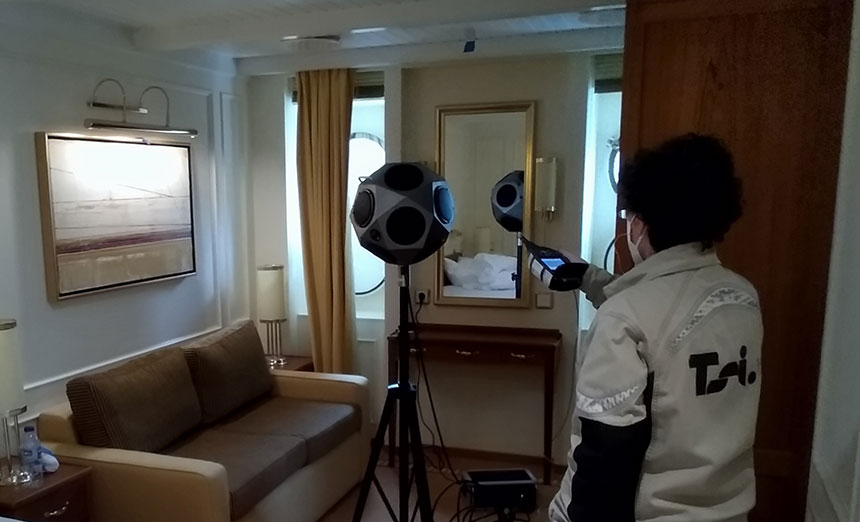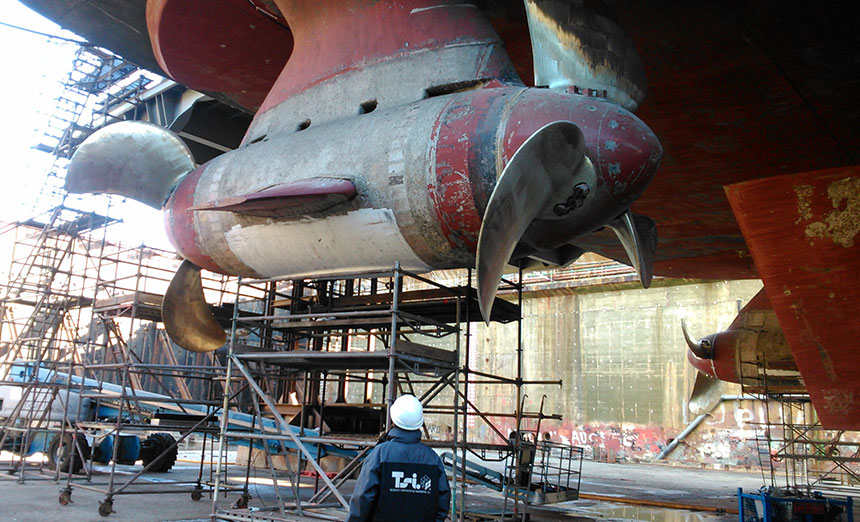
TSI, Specialist Engineering Services
The technical complexity and regulations relating to noise and vibration of machinery and ships demand the latest technology

CHALLENGE
Vibration and noise form a very specific and complex engineering discipline and may be decisive in numerous industrial areas and for the reduction of underwater noise in oceans. Involvement of a company specializing in these types of measurements is critical for players in this field. For industrial rotating machinery, the correct interpretation and analysis of the vibration measurements, in combination with other inspection, monitoring and control techniques, allows faults to be identified early on, reducing the cost of maintenance and repairs. Reducing underwater noise is critical not only for internal comfort, the environment and the future of numerous species, but also for the health of crews and the vessel itself. Sailing in a noisy ship can be harmful and noise can often be an indication of on-board vibration problems that can lead to equipment and system damage.
SOLUTION
TSI engineering combines the products of sound and vibration experts, Hottinger Brüel & Kjær, with its knowledge of on-board machinery, dynamics, acoustics and structures to facilitate the successful operation and maintenance of machinery and vessels. Concerning underwater noise, European regulations are devoting increasing attention to requiring very specialized systems that respond not only to the technical challenges but also to the current regulations. In this context, turning to a technology expert such as HBK guarantees success.
RESULTS
In the field of underwater noise, where measurement procedures and their standardization are surrounded by some uncertainty, HBK equipment provides reliable data on sound pressure levels, the spectral power density by unit of bandwidth and transmission loss, among other variables. All this is only possible with the use of cutting-edge technology.
Since 1983, TSI (Técnicas y Servicios de Ingeniería, S.L.) has been providing noise and vibration specialist services for the engineering industry. With the aim of providing effective and competitive top-level services adapted to the needs of its customers, TSI has been certified as a Service Supplier by different classification societies to carry out vibration and noise measurements worldwide.
After more than 35 years offering solutions and services in the field of machine and structural dynamics and acoustics, TSI has become an international benchmark in the measurement and analysis of noise and vibration, as well as in the domain of dynamic and shock testing. TSI’s work can be critical for its customers since the correct interpretation and analysis of measurements made on rotating machinery and structures allows incipient faults to be detected early, reducing the costs of maintenance and repair. TSI relies on Hottinger Brüel & Kjær (HBK) products to carry out vibration, noise, thermographic, ultrasound and endoscopic analysis. The company can also assess the condition of machinery, optimising preventive maintenance and reducing corrective maintenance.
TSI is also very active within Factory Acceptance Testing (FAT), using HBK products for this validation process. FATs are sets of tests that are carried out in the manufacturers’ facilities, where the noise and vibration of machines are assessed before being integrated into larger systems such as ships or industrial plants. Similarly, Site Acceptance Tests (SAT) are performed at customer sites – the final location of the equipment. Even though FAT and SAT tests are not always mandatory, they are included in the many contractual specifications outlined by the buyers of the equipment. Furthermore, these tests are considered as good practice providing quality control and verification points of the activities completed during the engineering design stages.
Other services offered by TSI include acceleration measurements for applications such as the design of anti-shock supports for, for example, electronic equipment consoles located in structures that are subject to high levels of vibration, as well as some specific dynamic tests based on the identification of modal parameters obtained from acceleration records in certain degrees of freedom of the structure, which must be independent and in sufficient number to characterise its movements.
TSI services also include measurements of torsional, axial and lateral vibrations of lines of shafting, dynamic balancing of rotating machinery, and alignment corrective tasks. Acoustic analysis studies, sound pressure measurements, sound insulation measurements, impact noise measurements, sound intensity measurements, acoustic audits, reverberation time measurements, etc., are also part of TSI’s offering, and aimed at verifying whether the measured levels comply with the noise thresholds stipulated by legislation, and the specifications and requirements set out in the technical specification sheets that may govern a contract.
In addition to all this, TSI uses state-of-the-art HBK technology to measure the exterior noise generated by all types of ships, in particular, underwater radiated noise (URN) and its impact on marine fauna and ecosystems. In fact, URN has become one of the current major technological challenges of civil shipbuilding, since noise is considered a pollutant, and the industry must comply with the increasingly demanding requirements of the European Union Directives, maritime institutions, and the scientific community. Thanks to TSI and HBK technology, Spanish civil shipbuilding is now more aware of this issue. This has led to an advance in the reduction of the underwater acoustic impact in new ship construction, especially in the fleet of oceanographic vessels. This type of high-tech ship is a market niche, with Spanish shipbuilders leading the way, meeting the strictest requirements and specifications, such as ICES N°209 on underwater noise of research vessels. This, in turn, has led to TSI taking a leading role in the construction of ‘silent vessels’, becoming specialist consultants on noise and vibration for shipbuilders up to the point of assisting them to become world-class technological benchmarks.
The acoustic impact of the vessels is considered one of the factors that contributes to the state of the environment. It is increasingly important for the ship industry and regulatory bodies to have measurement procedures that allow underwater noise radiated by vessels to be calculated correctly. And it is here where HBK products play a very important role. Some international standardization bodies, such as ANSI and ISO, have developed, and keep refining procedures for civil applications to quantify the emission of underwater noise of vessels. In TSI’s technical department, HBK’s role is perfectly clear. In their own words: “TSI has been using Brüel & Kjær sound level meters since the start of our operations in 1983. They contribute great value and reliability of results in the performance of our daily work. Currently, TSI’s technical department has three sound level meters (Types 2270 and 2260), an OmniPower Sound Source Type 4292, Power Amplifier Type 2734, Sound Intensity Probe Type 3599 and three Type 8104 hydrophones, to tackle the different measurement and test campaigns that are habitually carried out in the development of newly built ship and operational projects. The use of HBK technology at TSI is paramount for our operations, and also for carrying out routine measurements, validation measurements and as phenomena research tools.”
However, there are aspects of these procedures that are still not consolidated from a technical point of view, such as the measurement uncertainty associated with the procedures. Also, some topics have still not been addressed, such as measurements in shallow waters. As a result of its knowledge and expertise, and supported by state-of-the-art HBK technology, TSI can provide realistic values for the uncertainty and repeatability of the measurement procedure. Due to its impact on marine life, the reduction of underwater radiated noise by vessels has become the most prominent new issue and one of the toughest challenges for the shipbuilding industry – together with the decarbonisation of the propulsion. For this, the industry is attempting to provide new solutions that meet the new directives and requirements that have been recently developed and promoted by the EU, marine institutions and the scientific community.

Iscriviti alla nostra Newsletter e ricevi le informazioni più recenti dal mondo del suoni e delle vibrazioni


